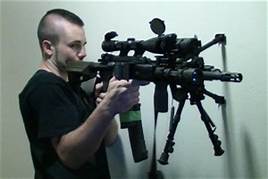2aguy
Diamond Member
- Jul 19, 2014
- 112,556
- 52,802
- 2,290
No need to as your said it quite elegantly. Some gun owners are selfish
They want more than what they need
continue this line of reasoning is why you see in Heller, what you want to see. Ignoring stuff that is uncomfortable.
First of all Heller was a case concerning hand guns and the ban on handguns by DC. Now you want to include assault riffles. The main argument of the people was owning hand guns in the home for self defense.
This very statement suggest that handguns can protect home owners who feel the need for it.
the SC concluded that the District’s functional ban on handgun possession in the home and the requirement that lawful firearms in the home be rendered inoperable were unconstitutional.
Very specific language yet it is the gun supporters who want to expand that interpretation using the heller decision.
yet the one wrench is there final conclusion
After announcing that the Second Amendment protects an individual’s right to possess firearms, the Supreme Court explained that, “[l]ike most rights, the right secured by the Second Amendment is not unlimited.
Thus suggesting that it can be limited in certain circumstances.
So if they have handguns, then what is the need for AR - 15 assault rifles. These rifles should be able to be limited.
No......you guys don't want to pay attention to what Scalia actually said........
https://www.supremecourt.gov/opinions/07pdf/07-290.pdf
Some have made the argument, bordering on the frivolous, that only those arms in existence in the 18th century are protected by the Second Amendment.
We do not interpret constitutional rights that way. Just as the First Amendment protects modern forms of communications, e.g., Reno v. American Civil Liberties Union, 521 U. S. 844, 849 (1997), and the Fourth Amendment applies to modern forms of search, e.g., Kyllo v. United States, 533 U. S. 27, 35–36 (2001),
the Second Amendment extends, prima facie, to all instruments that constitute bearable arms, even those that were not in existence at the time of the founding.
=======
And after Heller, Scalia elaborates on protected weapons in his opinion in Friedman v Highland Park.....
There are now well over 20 million AR-15 rifles in private hands...
https://www.supremecourt.gov/opinions/15pdf/15-133_7l48.pdf
The question under Heller is not whether citizens have adequate alternatives available for self-defense.
Rather, Heller asks whether the law bans types of firearms commonly used for a lawful purpose—regardless of whether alternatives exist. 554 U. S., at 627–629. And Heller draws a distinction between such firearms and weapons specially adapted to unlawful uses and not in common use, such as sawed-off shotguns. Id., at 624–625.
The City’s ban is thus highly suspect because it broadly prohibits common semiautomatic firearms used for lawful purposes.
Roughly five million Americans own AR-style semiautomatic rifles. See 784 F. 3d, at 415, n. 3. The overwhelming majority of citizens who own and use such rifles do so for lawful purposes, including self-defense and target shooting. See ibid. Under our precedents, that is all that is needed for citizens to have a right under the Second Amendment to keep such weapons. See McDonald, 561 U. S., at 767–768; Heller, supra, at 628–629.
A more detailed quote from Friedman...
Lastly, the Seventh Circuit considered “whether lawabiding citizens retain adequate means of self-defense,” and reasoned that the City’s ban was permissible because “f criminals can find substitutes for banned assault weapons, then so can law-abiding homeowners.” 784 F. 3d, at 410, 411.
Although the court recognized that “Heller held that the availability of long guns does not save a ban on handgun ownership,” it thought that “Heller did not foreclose the possibility that allowing the use of most long guns plus pistols and revolvers . . . gives householders adequate means of defense.” Id., at 411.
That analysis misreads Heller.
The question under Heller is not whether citizens have adequate alternatives available for self-defense. Rather, Heller asks whether the law bans types of firearms commonly used for a lawful purpose—regardless of whether alternatives exist. 554 U. S., at 627–629.
And Heller draws a distinction between such firearms and weapons specially adapted to unlawful uses and not in common use, such as sawed-off shotguns. Id., at 624–625.
The City’s ban is thus highly suspect because it broadly prohibits common semiautomatic firearms used for lawful purposes.
Roughly five million Americans own AR-style semiautomatic rifles. See 784 F. 3d, at 415, n. 3. The overwhelming majority of citizens who own and use such rifles do so for lawful purposes, including self-defense and target shooting. See ibid. Under our precedents, that is all that is needed for citizens to have a right under the Second Amendment to keep such weapons. See McDonald, 561 U. S., at 767–768; Heller, supra, at 628–629.
The Seventh Circuit ultimately upheld a ban on many common semiautomatic firearms based on speculation about the law’s potential policy benefits. See 784 F. 3d, at 411–412. The court conceded that handguns—not “assault weapons”—“are responsible for the vast majority of gun violence in the United States.” Id., at 409.
Still, the court concluded, the ordinance “may increase the public’s sense of safety,” which alone is “a substantial benefit.” Id., at 412.
Heller, however, forbids subjecting the Second Amendment’s “core protection . . . to a freestanding ‘interestbalancing’ approach.” Heller, supra, at 634. This case illustrates why. If a broad ban on firearms can be upheld based on conjecture that the public might feel safer (while being no safer at all), then the Second Amendment guarantees nothing.
III
https://www.supremecourt.gov/opinions/15pdf/15-133_7l48.pdf
